
This animation illustrates the movement of the three basic waves associated with an earthquake and the effect of these waves on a building.
- Subject:
- Earth Science
- Science
- Material Type:
- Lesson
- Provider:
- IRIS
- Author:
- IRIS
- Date Added:
- 02/26/2019

This animation illustrates the movement of the three basic waves associated with an earthquake and the effect of these waves on a building.

Students will demonstrate knowledge of visible light interactions with different materials and through different mediums (air, solids, and water). Students will use Sphero Bolt to create a flashlight. The goal is to create the brightest light from the LED lights on the Sphero BOLT. Students will need to understand how light interacts with different substances to successfully create the brightest flashlight. They will also test their lights in water to see how waves change direction and speed in different mediums. The Light intensity will be measured using the function in google science journal.

Each winter, massive waves attract surfers and visitors to the North Shore of Oahu in Hawaii. Some years, the waves cause severe erosion, and continuing sea level rise will accelerate this issue. Residents and the state are taking steps to preserve homes and beaches.

Based on knowledge of the unit Circles, students see how sinusoids (Sine and coSine waves) get their shapes.
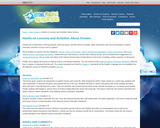
This article highlights hands-on or multimedia lesson plans about oceans. Science lessons are paired with suggested literacy lesson plans. All lessons are aligned to national standards.
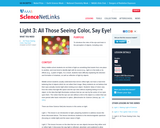
This lesson includes an Internet exploration that focuses on the roles of the eye and brain in the perception of color. It includes an introduction to the anatomy of the eye, including the functions of rods and cones. It is recommended that students complete the first 2 activities (Light 1 and Light 2) prior to this activity.
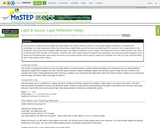
In this activity, students will investigate how light reflects off smooth surfaces (mirrors), learn about angles of reflection, and apply that knowledge in a relay experiment where they must direct a light beam around the room by reflecting it off 3 mirrors to hit a target placed in the classroom. Each group will investigate different paths and angles of reflection to hit a target. Once they have found a viable solution, they need to demonstrate their success to the teacher. Teachers will record observations throughout this exploration, documenting student progress in the groups and recording when each group has found a successful solution. Each group is required to complete one relay, but may continue hitting other relay targets as time allows.

The People's Physics Book v3 is intended to be used as one small part of a multifaceted strategy to teach physics conceptually and mathematically
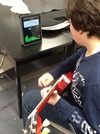
This is a PBL project that had students use musical instruments to demonstrate their mastery of waves and vibration. It was specifically designed to help students increase their depth of knowledge of vibration, wave fundamentals, wave interference, light and sound waves, and wave boundary effects. The project required students to use actual instruments to authentically present and justify their level of mastery to local musicians and other experts. Note that the project was designed and delivered per the North Carolina honors Physics curriculum and it can be customized to meet your own specific curriculum needs and resources.
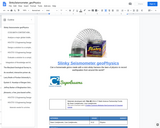
This unit uses the slinky seismometer as a means of studying physics concepts such as waves, sound and the speed of sound vs speed of light, resonance, electricity and magnetism, Lenz Law and magnetic dampening (backwards engineering). Students experiment with the basic parts of the seismometer and either build or connect the seismometer to the internet to take and upload data.
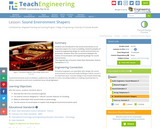
Students are introduced to the sound environment as an important aspect of a room or building. Several examples of acoustical engineering design for varied environments are presented. Students learn the connections between the science of sound waves and engineering design for sound environments.
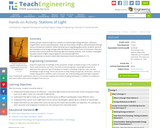
Student groups rotate through four stations to examine light energy behavior: refraction, magnification, prisms and polarization. They see how a beam of light is refracted (bent) through various transparent mediums. While learning how a magnifying glass works, students see how the orientation of an image changes with the distance of the lens from its focal point. They also discover how a prism works by refracting light and making rainbows. And, students investigate the polar nature of light using sunglasses and polarized light film.
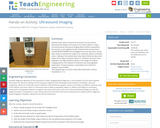
Students learn about ultrasound and how it can be used to determine the shapes and contours of unseen objects. Using a one-dimensional ultrasound imaging device (either prepared by the teacher or put together by the students) that incorporates a LEGO(TM) MINDSTORMS(TM) NXT intelligent brick and ultrasonic sensor, they measure and plot the shape of an unknown object covered by a box. Looking at the plotted data, they make inferences about the shape of the object and guess what it is. Students also learn how engineers use high-frequency waves in the design of medical imaging devices, the analysis of materials and oceanographic exploration. Pre/post quizzes, a worksheet and a LEGO rbt program are provided.
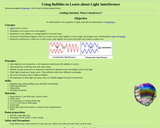
Students will investigate constructive and destructive interference by observing the light patterns on the surface of soap bubbles.

8th Grade Integrated Science textbook for the 2019-2020 school year. This textbook was developed to align to the Utah Science Core Curriculum. (Updated: May 29, 2019)

This online resource provides information about the different types of waves and how waves can be categorized based on distinguishing characteristics. A simple assessment is provided at the end of the text to check student understanding.
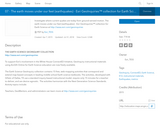
Investigate where current quakes are today from ground-sensed motion.
GeoInquiries are designed to be fast and easy-to-use instructional resources that incorporate advanced web mapping technology. Each 15-minute activity in a collection is intended to be presented by the instructor from a single computer/projector classroom arrangement. No installation, fees, or logins are necessary to use these materials and software.

This is a comprehensive encyclopedia entry that contains information about marine ecosystems, ocean zones, ocean currents, marine resources, and environmental issues associated with oceans. Text for this entry is appropriate for the middle and high school grade levels.